In terms of the amount of electricity that can be generated from the solar irradiation falling on each square meter of land or water, Taiwan’s southwest is one the most promising regions in East Asia.
Despite setting ambitious renewable-energy goals, the government isn’t willing to compel factory bosses and real-estate developers to install photovoltaic (PV) arrays on every suitable roof. Efforts to unlock the country’s solar-power potential have therefore focused on putting panels on schools and other public buildings, while offering incentives to property owners. South of Taichung, PV systems atop chicken coops, pigpens and warehouses are now a common sight. At the same time, a growing number of farmers are accepting subsidies to convert their fields into solar power plants.
The environmental ramifications of covering farmland with PV arrays aren’t as bad as sealing it beneath concrete. But any shift away from growing crops makes it less likely Taiwan will achieve a target set in 2011, and reiterated earlier this year by President Tsai Ing-wen (蔡英文), of boosting the country’s food self-sufficiency rate to 40 percent.
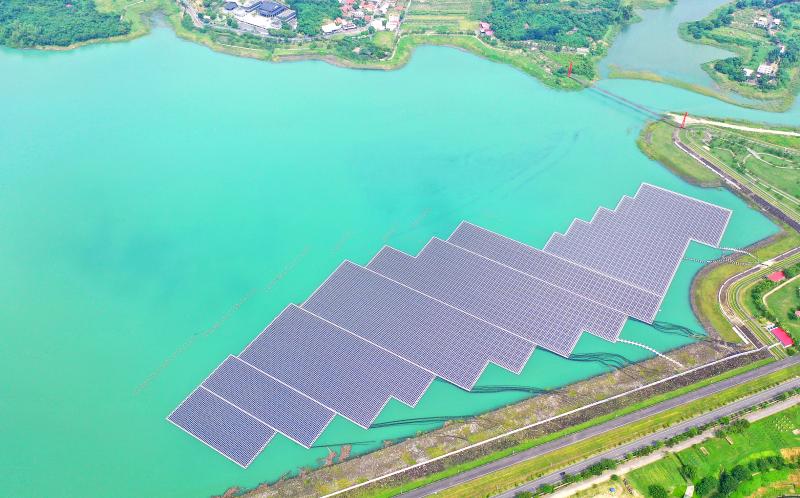
Photo courtesy of Ciel et Terre
In these circumstances, it’s hardly surprising that solar-energy entrepreneurs have turned their attention to ponds and fish farms. Floating photovoltaic (FPV) plants have proliferated since 2017, when a system on Agongdian Reservoir (阿公店水庫) in Kaohsiung began supplying Taipower.
The setup at Agongdian — which comprises 34,013 electricity-producing panels — is equipped with technology owned by Ciel et Terre, a French floating solar solution supplier and developer of large-scale FPV plants.
According to Hannah Wang (王詩涵), a senior saleswoman at Ciel et Terre’s Taiwan branch office, the system’s floats are manufactured in Taiwan of high-density polyethylene (HDPE), a plastic polymer that is 100 percent recyclable.
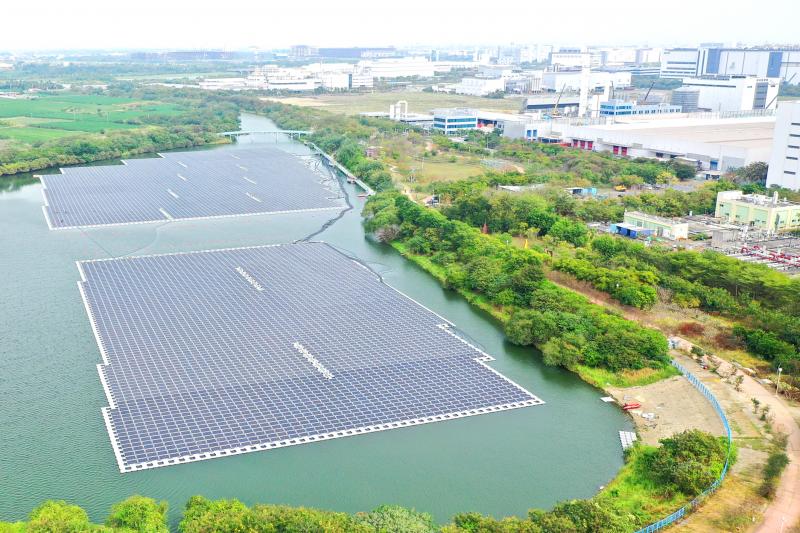
Photo courtesy of Ciel et Terre
Wang says Ciel et Terre technology can resist UV degradation for at least 25 years, and that all their products meet drinking-water standards set by the UK and other countries.
Responding to concerns that FPV arrays could affect water quality, a press release issued by Tainan City Government on Dec. 5 last year reassures residents that the floats are able to withstand UV radiation, water that’s unusually acidic or alkaline, and will neither oxidize nor dissolve. Using chemicals to clean the panels is prohibited.
Equipment, installation and maintenance costs for FPV are often 10 percent higher than for land or roof-based systems. However, these may be partly offset by more generous feed-in tariffs (FITs, the prices at which Taipower promises to buy electricity for 20 years following a system’s installation). Governments throughout the world use FITs to encourage investment in renewable energy.
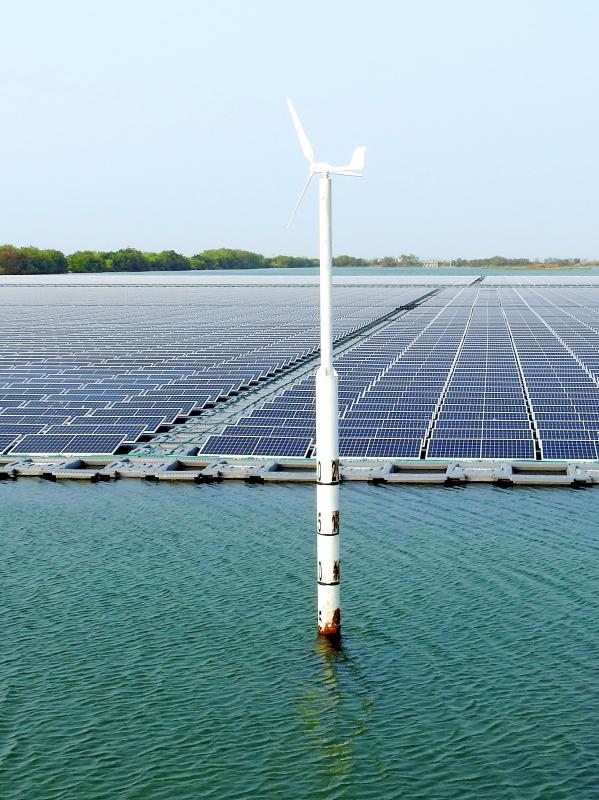
Photo: Steven Crook
In the second half of this year, Taipower’s basic FIT for FPV is NT$4.2709 per kWh. For ground-mounted systems, it’s NT$3.8752. For roof-mounted systems, the tariff varies from NT$5.7132 (for small arrays) to NT$3.9917. To make up for the north being less sunny, FITs for any type of solar power there are marked up 15 percent.
In warmer locations, FPV has two inherent advantages over roof- or ground-mounted systems. First, panels over water benefit from additional diffuse irradiation from water-surface reflections. Second, PV panels become less efficient in high temperatures, but this is mitigated by the cooling effect of the body of water. Some FPV advocates say these two factors can boost performance by as much as 10 percent.
FPV may bring environmental benefits beyond the generation of clean power. By reducing evaporation, large-scale floating systems could help conserve valuable freshwater. According to the Water Resources Agency, about 24 percent of the rain that falls on Taiwan is lost to evaporation. However, it’s possible that less evaporation would result in less precipitation.
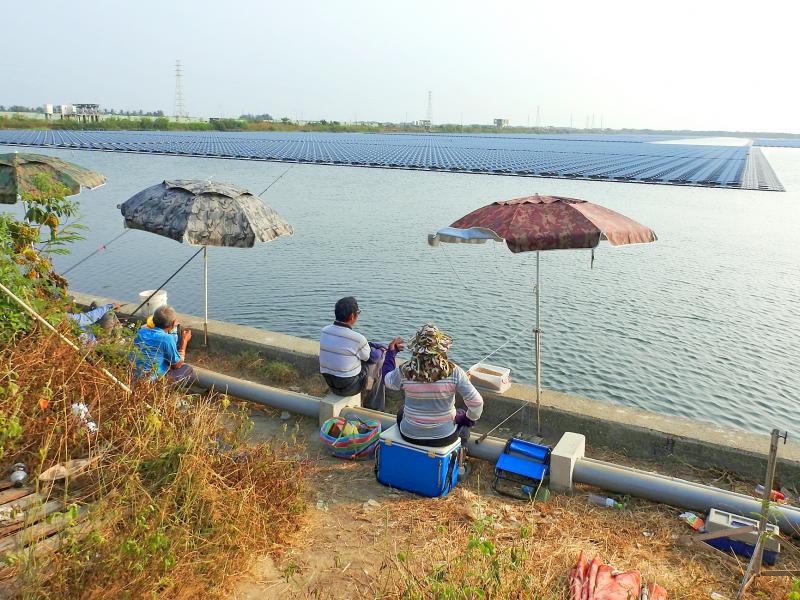
Photo: Steven Crook
If less sunshine hits the surface of the pond or reservoir, the water temperature may fall. The ecological consequences of this are hard to predict.
Some researchers suggest that, by reducing the amount of sunlight penetrating the water, FPV can improve water quality by inhibiting the growth of algae and limiting the conversion of bromide into bromate, a suspected human carcinogen.
At the same time, less algae means less food for certain insect and fish species, potentially upsetting the aquatic food chain. Obstruction is another issue.
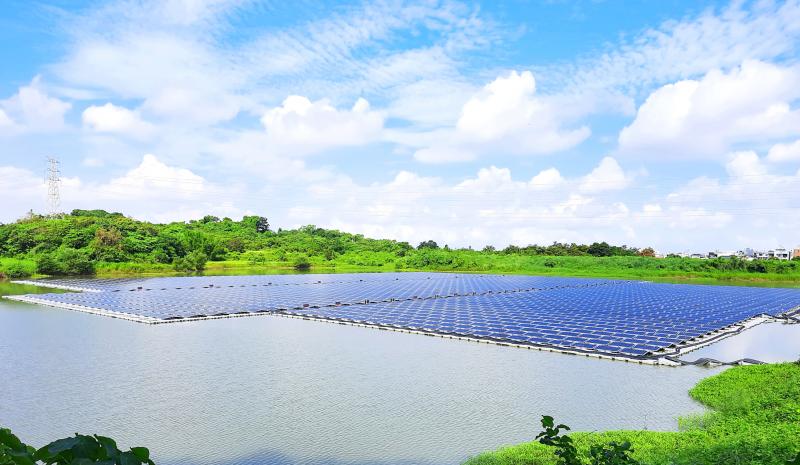
Photo: Steven Crook
“I’ve not seen any studies about this, but I’d assume that solar panels on top of a pond would definitely create difficulties for birds when they’re foraging,” says Victor Yu (余維道), president of Ecotourism Taiwan.
Within the FPV industry, birds are often seen as irritants. Baked-on bird droppings can etch the surface of panels and permanently reduce their efficiency. Some FPV owners in Europe have resorted to using lasers and other technologies to keep birds away.
Whether they’re floating, roof-mounted, or ground-mounted, PV systems in Taiwan must be able to withstand typhoons.
“The mooring for floating PV systems requires careful design and engineering. You don’t want an incident like the one in Japan last year,” says Lin Fen-yu (林芬玉), a project coordinator at Blue21, a Dutch company that designs and engineers floating urban projects. She refers to damage suffered by a FPV system at Yamakura Dam, not far from Tokyo, when typhoon winds ripped an array apart. Modules got stacked on each other, overheated and caught fire.
According to Lin, new technology in the pipeline would make it possible for an entire PV system to submerge when a storm approaches, then resurface after it’s passed.
“There’s definitely a lot of interest in FPV in Taiwan, and it’s a big market. In recent years, we’ve noticed an increasing number of patent applications from Taiwanese research institutes and companies for FPV innovations,” she says. “There are lots of suitable inland water bodies around the world, but the really big slice of pie is the offshore environment.”
Even in regions where typhoons aren’t a threat, however, building reliable maritime PV systems is challenging.
Vienna-based Swimsol GmbH, which has focused on FPV for marine environments since 2012, has developed corrosion-proof components made of high-grade aluminium and UV-resistant plastics, says managing director Martin Putschek. To reduce the stress on its platforms, the company has devised a float with a wireframe design that ensures just a small part comes into contact with waves.
“They pass through it without releasing their full force on impact,” says Putschek. “As our technology advances, markets like Taiwan or Japan could become interesting.”
Ciel et Terre has been dealing with similar issues at Taiwan’s largest FPV project, which occupies part of a rectangular cove between Changbin Industrial Zone (彰濱工業區) and Lunwei (崙尾) in Changhua County’s Lukang Township. The French company is supplying the floats and the system which fixes the PV panels to the floats.
“It may be the most challenging project we’ve encountered in Taiwan so far. Because it’s on an intertidal zone with seawater, we need to take great care to avoid rusting. Also, the capacity of this project is 88 mW [nine times’ that of the plant at Agongdian], so quality control and the delivery schedule are key for our client, which expects grid-connection at the end of this year,” says Ciel et Terre’s Wang.
Asked if freshwater will have to be transported to the cove to clean the solar panels, Wang says that for FPV arrays on freshwater, filtered pond water is often good enough, but that “this method isn’t suitable for saltwater, and we don’t know how our client will solve this problem.”
One feature of the Changbin FPV plant has come in for criticism. When the tide goes out, part of the vast array settles on the silt, which surely isn’t good for the crabs and other creatures that inhabit the mudflats. An environmentalist who took drone photos, and shared them on social media under the name Drifting Island (漂浪島嶼), exclaimed: “It is no exaggeration to say the ground has been tiled over!”
Wang claims that the shape of Ciel et Terre’s floats ensures there’s no paving effect.
On July 2, 2020, the United Daily News reported that, because the location has long been classified by the government as an industrial zone, rather than an intertidal zone, no environmental impact assessment has been required since the one completed more than 30 years ago, long before Taiwan embraced solar energy.
Blue21’s Lin isn’t familiar with the Changbin project, but says: “All over the world, the ecological impact of floating PV solar has been overlooked. This is a serious issue, and it should be addressed ASAP.”
Steven Crook, the author or co-author of four books about Taiwan, has been following environmental issues since he arrived in the country in 1991. He drives a hybrid and carries his own chopsticks.

March 10 to March 16 Although it failed to become popular, March of the Black Cats (烏貓進行曲) was the first Taiwanese record to have “pop song” printed on the label. Released in March 1929 under Eagle Records, a subsidiary of the Japanese-owned Columbia Records, the Hoklo (commonly known as Taiwanese) lyrics followed the traditional seven characters per verse of Taiwanese opera, but the instrumentation was Western, performed by Eagle’s in-house orchestra. The singer was entertainer Chiu-chan (秋蟾). In fact, a cover of a Xiamen folk song by Chiu-chan released around the same time, Plum Widow Missing Her Husband (雪梅思君), enjoyed more

Last week Elbridge Colby, US President Donald Trump’s nominee for under secretary of defense for policy, a key advisory position, said in his Senate confirmation hearing that Taiwan defense spending should be 10 percent of GDP “at least something in that ballpark, really focused on their defense.” He added: “So we need to properly incentivize them.” Much commentary focused on the 10 percent figure, and rightly so. Colby is not wrong in one respect — Taiwan does need to spend more. But the steady escalation in the proportion of GDP from 3 percent to 5 percent to 10 percent that advocates

From insomniacs to party-goers, doting couples, tired paramedics and Johannesburg’s golden youth, The Pantry, a petrol station doubling as a gourmet deli, has become unmissable on the nightlife scene of South Africa’s biggest city. Open 24 hours a day, the establishment which opened three years ago is a haven for revelers looking for a midnight snack to sober up after the bars and nightclubs close at 2am or 5am. “Believe me, we see it all here,” sighs a cashier. Before the curtains open on Johannesburg’s infamous party scene, the evening gets off to a gentle start. On a Friday at around 6pm,

A series of dramatic news items dropped last month that shed light on Chinese Communist Party (CCP) attitudes towards three candidates for last year’s presidential election: Taiwan People’s Party (TPP) founder Ko Wen-je (柯文哲), Terry Gou (郭台銘), founder of Hon Hai Precision Industry Co (鴻海精密), also known as Foxconn Technology Group (富士康科技集團), and New Taipei City Mayor Hou You-yi (侯友宜) of the Chinese Nationalist Party (KMT). It also revealed deep blue support for Ko and Gou from inside the KMT, how they interacted with the CCP and alleged election interference involving NT$100 million (US$3.05 million) or more raised by the